Happy Darwin Day!
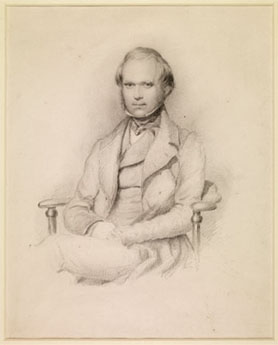 |
| Charles Darwin by George Richmond. Cambridge University Library. |
Today in 1809, Charles Darwin, remembered for his theory of Evolution by means of Natural Selection (which was so eloquently outlined in the 1859 publication On the Origin of Species by Means of Natural Selection) was born. We celebrate this day as Darwin Day.
In 2011, BHL released Charles Darwin’s Library, a collection of books found in Charles Darwin’s personal library, with his hand-written annotations marked-up and indexed. We made a selection of these books available for free download in iTunes U. This year, we’ve selected images from these books and created a Darwin collection in Flickr. As with all BHL content, these images are free for download and reuse.
As we continue our celebrations of this great man of science, we highlight another project (headquartered at the American Museum of Natural History) which is dedicated to providing free access to Charles Darwin’s scientific manuscripts – the Darwin Manuscripts Project.
In this two-part post, Darwin Manuscripts Project Director, David Kohn, examines four of Darwin’s manuscripts that show the development of his evolution theory. Let’s begin with excerpts from “Ornithology Notes” and Darwin’s “Transmutation Notebook.”
Celebrating Darwin Day. By David Kohn. Director, Darwin Manuscripts Project
The Darwin Manuscripts Project has the admittedly ambitious goal of publishing all of Darwin’s scientific manuscripts. When digitized this will come to well over 100,000 high-resolution images, which we aim to faithfully transcribe and edit to the exacting standards of contemporary textual and historical scholarship. Among all these manuscripts my first love has always been those items that reveal—or at least allow us to glimpse at—the development of Darwin’s commitment to transmutation (his term for evolution) and the insights that led him to natural selection and eventually to the Origin of Species. Beyond their intellectual content, what appeals to me is how passionate are these manuscript glimpses of Darwin deeply in the midst of theory creation. So I’ve selected three items that capture chronological high points in what must be the most crucial intellectual journey in the history of natural history. And then I’ve selected two manuscript pages from the end point of the journey—the Origin itself. The entirety of this journey can easily be followed on the DMP site by going to Edited Manuscripts (in the left-hand navigation) and then selecting ‘Creation of the Origin’, where the reader will find all the many surviving documents that are relevant to this process from 1835 to 1859.
Ornithology Notes, Summer 1836
(Cambridge University Library, DAR 29.2: 73-74)
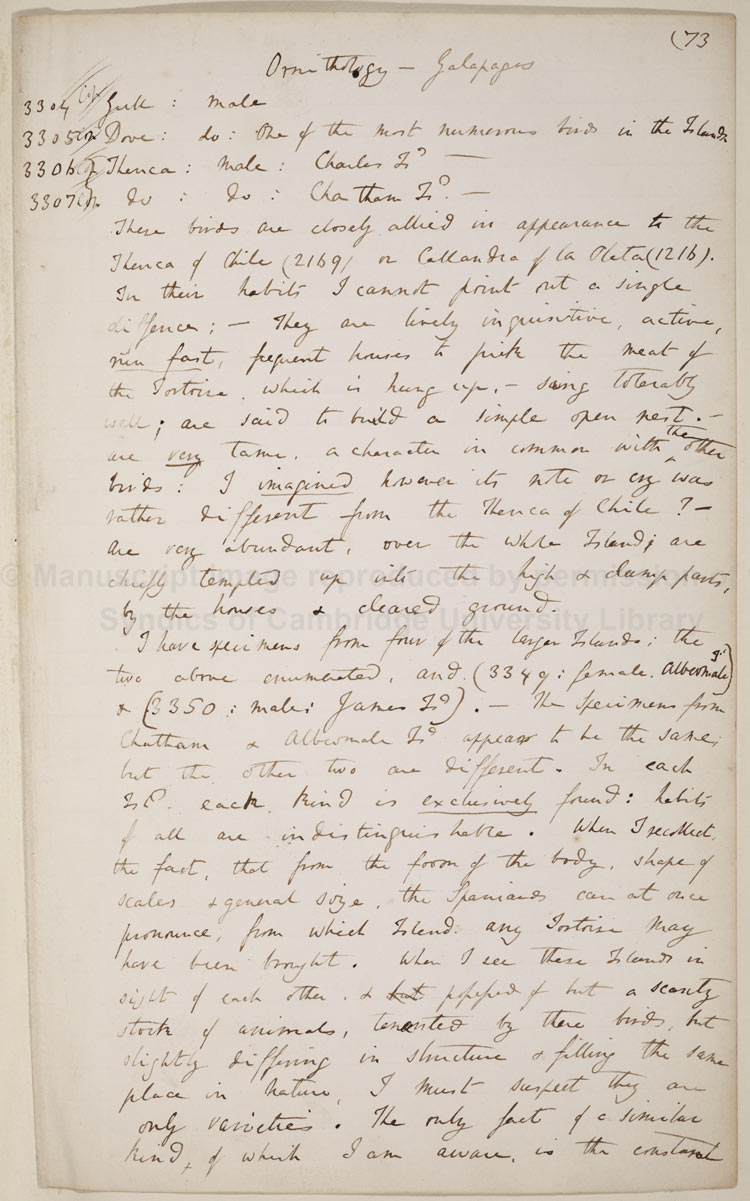 |
| Ornithology Notes. Pg. 73. Cambridge University Library. |
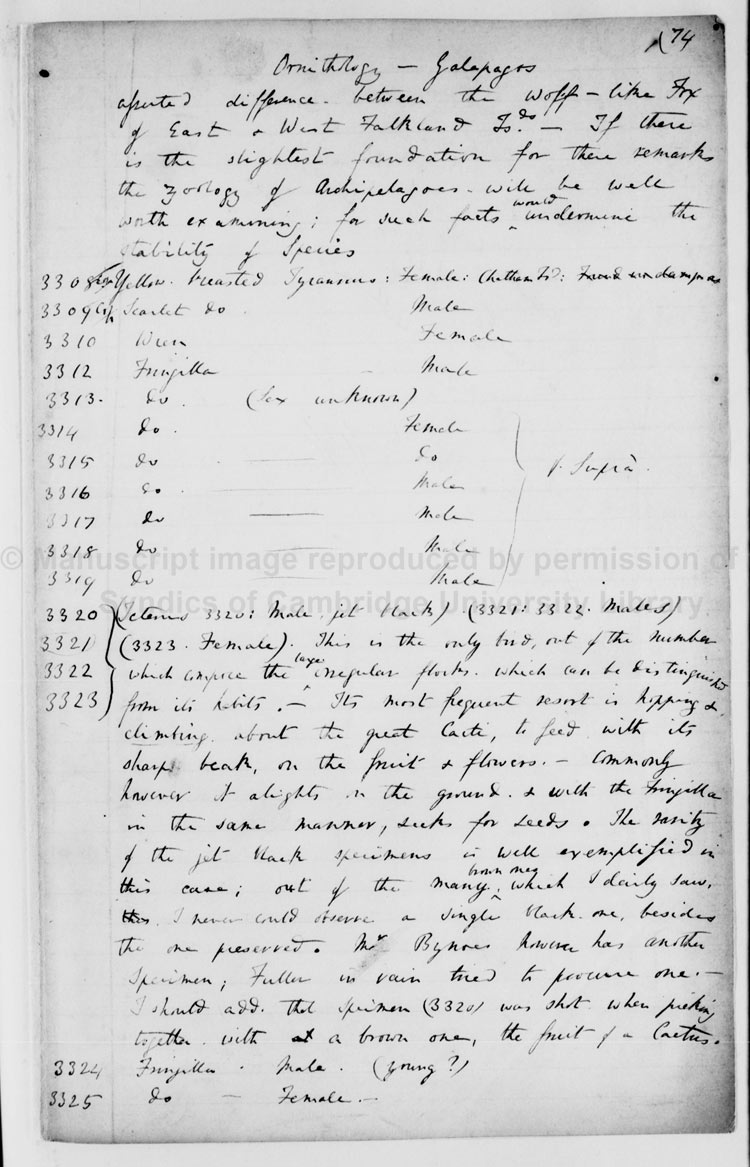 |
| Ornithology Notes. Pg. 74. Cambridge University Library. |
I want to focus on the following passage about the slightly different forms of mocking birds Darwin found as he travelled from island to island. This was written in the summer of 1836 and is a significantly revised version of notes written in 1835, shortly after the Beagle left the Galapagos.
“When I see these Islands…tenanted by these [mocking] birds…I must suspect they are only varieties. … If there is the slightest foundation for these remarks the Zoology of Archipelagoes, will be well worth examining; for such facts «would» undermine the stability of Species.”
What a tantalizing passage. What does he mean by the concluding remark: ‘undermine the stability of Species’?
Undoubtedly, this remains one of the most controversial passages in the Darwin manuscript corpus. And I am offering a part of my humble, yet accurate, interpretation. By ‘stability’ Darwin means immutability. For stability of species is the exact term that Charles Lyell used when he discussed Lamarck’s evolutionary theory at length in the Principles of Geology. By 1836, Darwin had almost four years to read Lyell. And we know definitively he had read and indeed thought about Lyell’s anti-evolutionary views by February 1835. While there are several ways that Darwin was exposed to evolution before the voyage, Lyell’s deep exposition of Lamarck was, I believe, the most important exposure. For reading Lyell gave Darwin a major and thorough injection of evolution theory at the very time when Darwin was actively collecting specimens. But this belief has to be a matter of guess work because Darwin did not begin annotating his books until after the Beagle voyage. (If you really want to have some fun browse through the heavy marginalia on Darwin’s immediately post-Beagle copy of the 1837 edition of Lyell’s Principles in the Charles Darwin’s Library collection at BHL: http://biodiversitylibrary.org/item/105893 and http://biodiversitylibrary.org/item/105574.)
So to me ‘undermine the Stability of species’ translates as to ‘negate immutability’. Logically, to negate immutability equates to assert evolution. But in this passage Darwin did not assert evolution—not yet. We learn that the logic of discovery can proceed more gradually than mere logic. However, this passage is an extremely important index of Darwin’s intellectual development. For while it shows that Darwin was not yet an evolutionist, it also shows that he was thinking about evolution and indeed thinking that evidence he had collected could destroy the received view that species are perpetually immutable.
Some more context is necessary. When he wrote this passage, Darwin was in the midst of an important transition. South America and the years of specimen collecting were long behind him. So as a scientific expedition, the voyage itself was behind him. Yet with the ship homeward bound in the Atlantic, the voyage had not yet ended. But Darwin is already looking to the near future, when he would make a powerful entrance into London’s scientific scene by delivering his Beagle specimens to specialists to identify, describe, and evaluate. For these are the people who will determine whether or not his evidence on the ‘Zoology of Archipelagoes, will be well worth examining’. But now, while still sailing, Darwin was prepared to speculate, and indeed to set the grounds for his future evolutionary theorizing.
Transmutation Notebook D 134e-D135e, 28 September 1838
(Cambridge University Library, DAR 208: 73-74, http://darwin.amnh.org/viewer.php?eid=75168 and http://darwin.amnh.org/viewer.php?eid=75169. For the whole Notebook D see http://darwin.amnh.org/viewer.php?mid=7.)
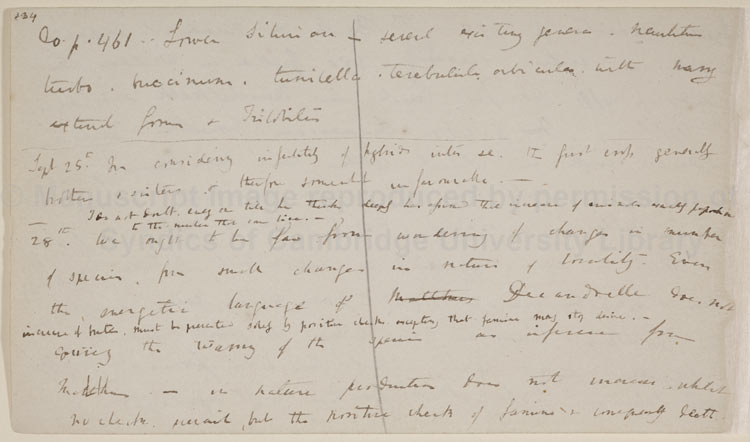 |
| Transmutation Notebook D. Pg. 134e. Cambridge University Library. |
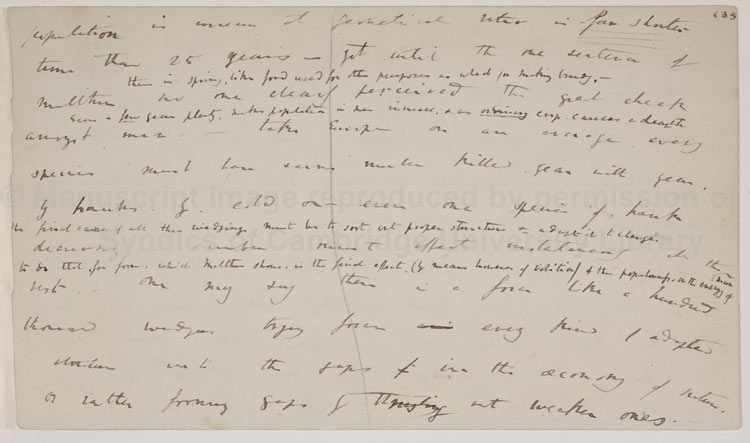 |
| Transmutation Notebook D. Pg. 135e. Cambridge University Library. |
28th. «I do not doubt, every one till he thinks deeply has assumed that increase of animals exactly proportiona[l] to the number that can live.—» We ought to be far from wondering of changes in number of species, from small changes in nature of locality. Even the energetic language of ‹Malthus› «Decandoelle» does not convey the warring of the species as inference from Malthus.— … population in increase at geometrical ratio in FAR SHORTER time than 25 years— yet until the one sentence of Malthus no one clearly perceived the great check amongst men.— … One may say there is a force like a hundred thousand wedges trying force ‹into› every kind of adapted structure into the gaps ‹of› in the œconomy of Nature, or rather forming gaps by thrusting out weaker ones. «The final cause of all this wedgings, must be to sort out proper structure & adapt it to change.—»
These two pages from the third of Darwin’s ‘Notebooks on the Transmutation of Species’ give us a window into another crucial moment, for here we see Darwin’s profound excitement as he responds to reading Malthus’ Essay On Population. Visually, I have always been struck by Darwin’s uncharacteristically small, yet very well formed, handwriting here. And notice how there seems to be at least two layers of writing. Indeed the pages are so densely packed that in some places scholars have difficulty cleanly separating the layers.
But, what is Darwin saying? Well, you need to know that by September 1838, Darwin was deeply engaged in what became the two branches of his life’s work. One branch was the constant weighing of the evidence for and against evolution, though by March 1837—so about six months after the Ornithology Notes, he was convinced that the mutability of species was the way nature is organized—evolution is a correct theory. The other branch was Darwin’s search to define mechanisms that explain two things: how species acquire adaptations and how new species are formed. In these two pages Darwin is, for the very first time, beginning to formulate the essence of the mechanism for adaptive evolution, namely: by natural selection. No wonder he writes with so much energy, and yet with so much precision. What he does here is grasp the power of Malthus’ population pressure—‘the energetic language of Malthus,’ which he then harnesses as a natural agent that through the differential survival of the fittest—‘forming gaps by thrusting out weaker ones’ can thereby ‘sort out proper structure & adapt it to change’. This is the essence of natural selection. Not the grown tree in full bloom. But it is more than just a seed, for if theories are like trees, at this stage Darwin’s was a healthy sapling.
(To Be Continued…View part 2 of this blog post.)
Images in this post reproduced with the permission of the Syndics of Cambridge University Library.
___________________________
Explore Darwin on BHL and the Darwin Manuscripts Project:
Charles Darwin’s Library
Charles Darwin’s Library on iTunes U
Charles Darwin’s Library on Flickr
Darwin Manuscripts Project
Official Darwin Day Website





Leave a Comment